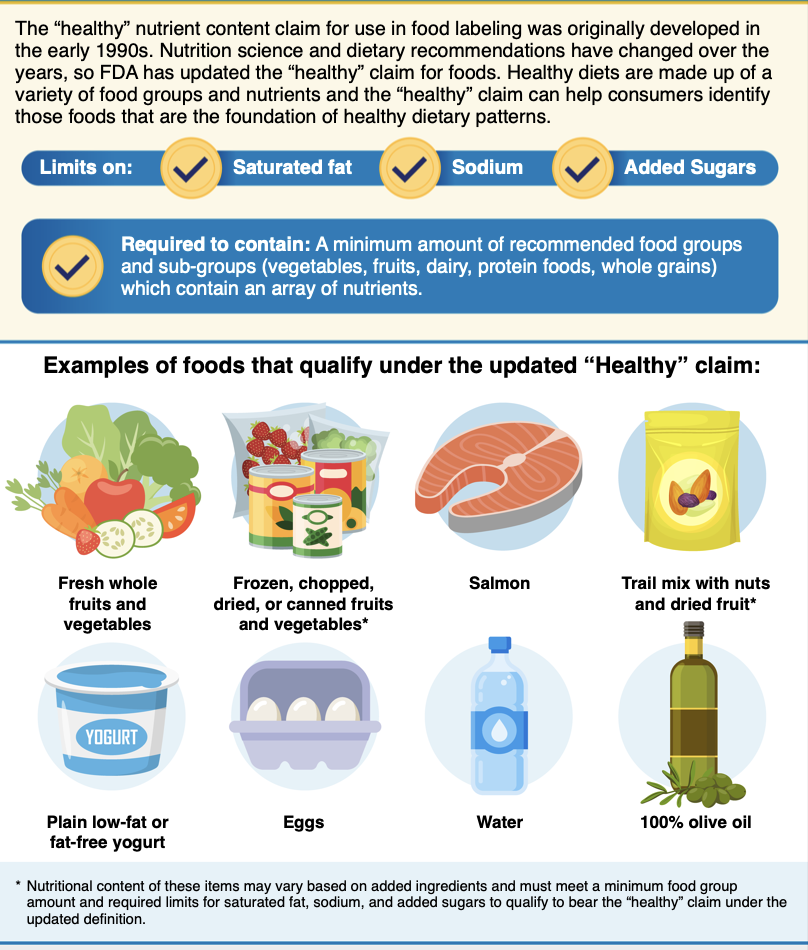In a significant move aimed at helping consumers make healthier food choices, the U.S. Food and Drug Administration (FDA) has finalised its updated “healthy” nutrient content claim. This rule, which reflects the latest nutrition science and aligns with the Dietary Guidelines for Americans, is designed to aid consumers in identifying foods that support a balanced diet and contribute to overall health and wellness. The updated criteria offer a more precise and scientifically backed definition of what constitutes a “healthy” food, empowering individuals to make informed dietary decisions.
Aligning with Current Nutrition Science and Dietary Guidelines
The revised “healthy” claim criteria are in line with the most recent advancements in nutrition science and are consistent with the federal government’s Dietary Guidelines for Americans (DGAs). These guidelines serve as the cornerstone of nutrition advice in the United States and emphasise the importance of eating a variety of nutrient-rich foods from all food groups, including fruits, vegetables, dairy, and whole grains. The updated criteria for the “healthy” claim are also synchronised with the updated Nutrition Facts label, which now includes a declaration of added sugars, ensuring consumers have access to the most accurate information to guide their food choices.
Key Updates to the ‘Healthy’ Nutrient Content Claim
Under the finalised rule, a product must meet several requirements to qualify for the “healthy” claim on its packaging. Key changes include:
- Food Group Requirements: To bear the “healthy” claim, a product must contain a certain amount of food (food group equivalent) from at least one of the food groups or subgroups recommended by the Dietary Guidelines, such as fruits, vegetables, whole grains, or fat-free and low-fat dairy products. This ensures that the claim is reserved for foods that are integral to a balanced and nutritious eating pattern.
- Nutrient Limits: The updated criteria establish specific limits for nutrients that should be consumed in moderation, namely saturated fat, sodium, and added sugars. Foods with excessive amounts of these nutrients are excluded from using the “healthy” claim, reinforcing the need for consumers to avoid foods that could contribute to diet-related chronic diseases, such as heart disease, diabetes, and obesity.
For example, breakfast cereals that qualify for the “healthy” claim must contain a specified amount of whole grains and meet the limits for saturated fat, sodium, and added sugars. Previously, many nutrient-dense foods, such as nuts, seeds, higher-fat fish like salmon, certain oils, and water, did not meet the requirements to bear the “healthy” label. However, these foods—now recognised as part of a healthy eating pattern and included in the updated Dietary Guidelines—can now proudly display the “healthy” claim.
Timeline for Implementation
The FDA’s final rule is set to officially go into effect on 25 February 2025, giving manufacturers three years, until 25 February 2028, to comply with the updated requirements. This transition period provides ample time for businesses to adjust their formulations and packaging to meet the new criteria. Manufacturers who choose to use the “healthy” claim on their products may begin implementing the updated guidelines sooner if they wish.
A Long-Awaited Update: The Path to the Final Rule
The FDA first began regulating the use of the “healthy” claim on food labels in 1994. However, while the agency has periodically updated guidelines related to nutrition facts labels, serving sizes, and the Daily Value (DV) of certain nutrients, the definition of “healthy” had remained outdated. The agency’s effort to redefine the term began in 2016 with the initiation of a rulemaking process, starting with a request for public comments on what advertising foods as “healthy” should actually mean.
In September 2022, the FDA issued a proposed rule to revise the definition of “healthy” to better reflect foods that support healthy dietary practices. After reviewing over 400 public comments, the FDA finalised the rule in 2025, incorporating significant updates that modernise the criteria for using the “healthy” claim. As a result of the new rule, some foods that previously qualified as “healthy” no longer meet the updated criteria. Examples include fortified white bread, highly sweetened yoghurt, and sugary cereals.
Highlights from the New Rule
Though not exhaustive, the new rule introduces several important changes. Here are some key provisions:
- Saturated Fat, Sodium, and Added Sugars Limits: The new rule imposes strict limits on saturated fat, sodium, and added sugars. For instance, sodium content must stay below 10% of the daily value per serving to qualify for the “healthy” claim.
- Minimum Nutrient Requirements: Foods must contain a meaningful amount of nutrients derived from food groups such as fruits, vegetables, grains, protein, and dairy to be eligible for the claim.
- Automatic Qualification: Certain foods without added ingredients (other than water) will automatically qualify for the “healthy” claim. These include vegetables, fruits, whole grains, beans, peas, seafood, and nuts. Additionally, water, tea, and coffee with fewer than 5 calories per serving will automatically be eligible.

What’s at Stake?
The FDA’s enforcement of the “healthy” claim ensures that the term is used correctly and consistently. Misusing the term could result in significant consequences, including FDA enforcement actions such as warning letters or product recalls. Additionally, competitors closely monitor the use of the term, and challenges in federal court or the National Advertising Division (NAD) for false advertising could arise. Plaintiffs’ attorneys may also file false advertising claims under state consumer protection laws if they believe a product is misleadingly labelled as “healthy.”
Impact on Everyday Food Choices
The updated guidelines also open the door for a wider variety of foods to carry the “healthy” label, including products that are both nutritious and accessible across different price points. For instance, some peanut butters and canned fruits and vegetables are now eligible to use the “healthy” claim, making it easier for consumers to identify healthy options, regardless of their budget. This is a crucial step in promoting health equity, as access to affordable nutritious food is essential in reducing diet-related health disparities.
Voluntary Compliance and Industry Response
Manufacturers who choose to use the “healthy” claim on their products will have a three-year transition period to comply with the new criteria. However, they can opt to implement the updated standards sooner. This voluntary compliance gives food producers ample time to adjust their formulations and labelling practices, ensuring that consumers benefit from clearer, more reliable information about what qualifies as a nutritious food option.
Future of Food Labelling: The ‘Healthy’ Symbol
As part of this broader effort, the FDA is also working on developing a symbol that could appear on food labels to visibly indicate that a product meets the updated criteria for the “healthy” claim. This symbol would provide an easy-to-understand visual cue for consumers, further simplifying the process of selecting foods that align with dietary recommendations and promote better health outcomes.
A Step Towards Reducing Chronic Diseases
This initiative is part of the FDA’s larger commitment to combating diet-related chronic diseases, promoting health equity, and supporting public health efforts across the nation. By aligning food labelling with the latest nutrition science and providing consumers with clear, actionable information, the FDA is taking steps towards creating an environment where making healthy food choices is easier and more accessible for everyone.
These efforts are also a key part of the White House’s National Strategy on Hunger, Nutrition, and Health, which aims to reduce the prevalence of diet-related chronic diseases and improve overall health outcomes in the U.S.
Conclusion
With the finalisation of the updated “healthy” nutrient content claim, the FDA has made significant progress towards making healthy eating more attainable for all Americans. By using science-backed criteria that align with the Dietary Guidelines for Americans, consumers will now have better tools to navigate the food environment and make choices that support their health and well-being. The move also provides a clearer path for food manufacturers to label their products in a way that helps build a healthier food system for all.
Stakeholder Webinar
To provide clarity on the updated rule and answer questions, the FDA will host a stakeholder webinar in the near future. Details about the webinar will be shared soon.
For more information on the updated “healthy” claim and the FDA’s broader initiatives, visit the FDA’s website.
FDA Finalizes Updated ‘Healthy’ Nutrient Content Claim
For more information:
https://www.fda.gov/food/nutrition-food-labeling-and-critical-foods/use-term-healthy-food-labeling
FDA Fact Sheet
https://www.fda.gov/media/184538/download?attachment
https://www.fda.gov/media/184535/download?attachment
FDA Infographic

